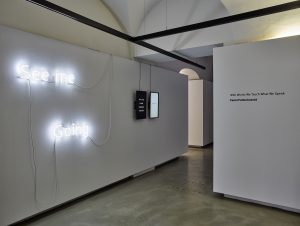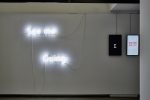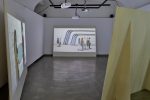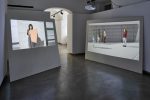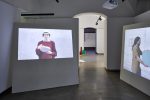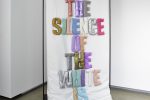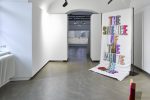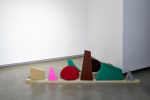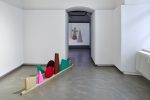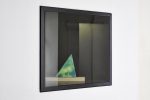With Words We Touch What We Speak
Fanni Futterknecht
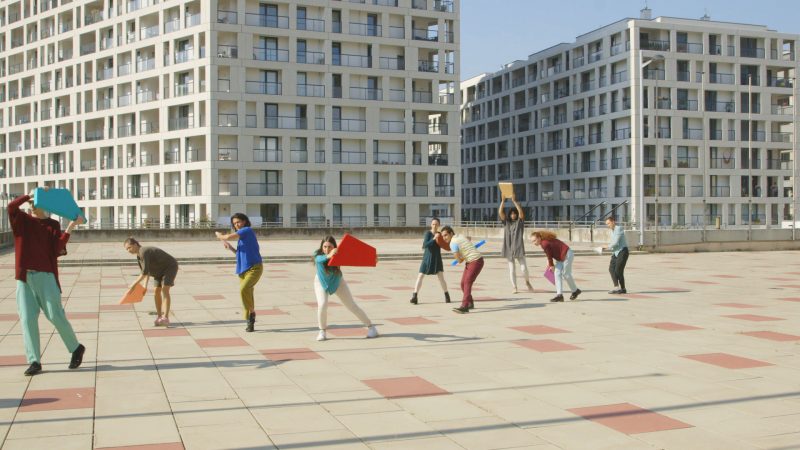
With Words We Touch What We Speak
Fanni Futterknecht’s works adopt a position that spans media, ranging between video, performance and installation.
In her works she reflects on sociological and social questions, converting them into poetic interpretations. In spatial and plastic realizations and translations, and by means of language, the artist works on – in the form of performance, demonstrations, videos and installations – the construction and deconstruction of scenarios. Performance-installations are understood as processual sculptures, transforming creatively during their staging.
Part of this investigation is a concern with processes of media translation and a questioning of the media employed in each context: the translation of the performance into a video. The video as an exhibition. The installation as a performance.
The exhibition With Words We Touch What We Speak leads visitors through a dramaturgy constructed by the artist. Here, dramaturgy should be understood according to Gottfried Fischborn’s definitition. In his words, the term refers : “[…] to all processual and structured activities, communicative acts (including acts of speech), sequences of events and processes in people’s social as well as individual lives, in the sphere of symbolic representation as well as everyday life, in reality as well as in the arts.”[1]
Narration is created by moments, performative patterns, actions, situations, conditions and aspects.
There is an absurdity inherent in all this, which is constructed deliberately in order to question the real social discourse with a certain irony, without making a concrete statement of any kind. Poetic handling translates moments into a language of their own: a language that addresses the viewer directly and identifies things in their simplicity and materiality.
In the video installation Across the White things evolve on the basis of their full formulation, in an empty white space that functions as a projection surface for the performative act, which represents power relations that are read as concepts.
The conflict realized between the characters – through the spoken word – is manifest in graphic form in the object The Silence of the White is Gone.
The group as a unit, the individual in him- or herself, and images of their encounters and conflicts structure the space-consuming 3-channel video installation, Voices of Concrete. A dualism that captures the emergence of ideologies and the associated control over individuals’ behaviour is the theme here. The protagonists act in choreographed images and their speech is translated into a silent graphic form. There is no narrative, but a dramaturgy of states and moments in images and text.
The objects Accumulation 1-2-3, re-adopted from the video installation, symbolize the discourse examined above. They are not what they are: with arbitrarily chosen colours and forms, interchangeable at any time, they nestle in the hands of the protagonists. In the exhibition space they are arranged like models, leaning against the sparse, urban, modernist architecture in which the protagonists operate in the videos.
The video poems I and It negate the image of the protagonist and allow the text itself to become the speaker. There is a performative aspect inherent in these text poems; they address the viewer directly.
At the exit, which is also an entrance, the glow of the neon writing See me Going is verbalized as poetry in space, announcing – a paradox – the moment of disappearance.
[1] Gottfried Fischborn, Theatralität – Dramaturgie – Dramatisierung, in: Politische Kultur und Theatralität. Peter Lang, Frankfurt am Main 2012, S. 15–24.
Fanni Futterknecht studied Fine Art and Video at the Gerrit Rietveld Akademie Amsterdam and the Academy of Fine Arts Vienna, and Scenic Arts in the context of the programme “Essais” at the CNDC in Angers, France.
Performances/ Exhibitions/ Residencies/ Grants (selection):
2017 Tokyo Grant, BKA Austria, Tokyo (JP); 2016 Wenn Worte auf Farben reiten, Ausstellungsbrücke St.Pölten; What Remains is Tomorrow, Badener Kunstverein; I wish I could speak in technicolour, performance, Théâtre de la Cite Paris; Air Hospiz residency Arlberg; Screen as a Room, Substation, Melbourne; Films of one’s own, Seventh Gallery, Melbourne; 2015 Across The White, performance and installation, Im Ersten, Vienna; Air Niederösterreich, RMIT, Melbourne; residency International Recollets, Paris; Across the White, Galerie 5020 Salzburg; Aufgerissenen Auges, Xhibit Academy of Fine Arts, Vienna; Perpetuum Mobile, Garage Kunsthaus Vienna; Air Melbourne State of Lower Austria, Melbourne; 2014 Parallel Artfair, Vienna; Formen und Sequenzen, exhibition with Andreas Kurz, Kunstraum Super, Vienna; The movement of the whole, Inda Galerie, Budapest; Cutlog, artfair New York; residency Watermill Center Hamptons, New York (US); An object with a sharp beginning_, film performance WUK Vienna; Air Grant Robert Wilson Watermillcenter New York (US); London/Vienna Calling, Semperdepot VIENNA; Szene Salzburg, residency; 2013 Principium Privatum – Projizierte Sexualitäten, Vienna Art Week, moe, Vienna; Kunstgastgeber Gemeindebau Rennbahnweg; Kör London/Vienna Calling Exhibition Mile End Art Pavillion; S/he is the one, performance, Kunstraum Niederösterreich; Die Chic Boutique @ SWDZ (So Weit, die Zukunft); In der Kubatur des Kabinetts, der kunstsalon im Fluc, Vienna; Kulturdrogerie with Ursula Maria Probst and Jakob Neulinger; La Souterrain, residency Zitrodruck, Zurich (CH); 2012 State Promotional Award, foreign studio, Shanghai, bka
